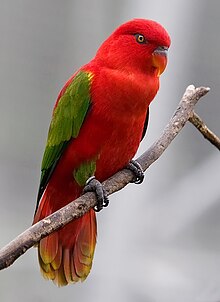The chattering lory (Lorius garrulus) is a forest-dwelling parrot endemic to North Maluku, Indonesia. It is considered vulnerable, the main threat being from trapping for the cage-bird trade.
| Chattering lory | |
|---|---|

| |
| At the Jurong Bird Park in Singapore | |
| Scientific classification | |
| Domain: | Eukaryota |
| Kingdom: | Animalia |
| Phylum: | Chordata |
| Class: | Aves |
| Order: | Psittaciformes |
| Family: | Psittaculidae |
| Genus: | Lorius |
| Species: | L. garrulus
|
| Binomial name | |
| Lorius garrulus | |
| Synonyms | |
|
Psittacus garrulus Linnaeus, 1758 | |
The race L. g. flavopalliatus is known as the yellow-backed lory.
Taxonomy edit
The chattering lory was formally described by the Swedish naturalist Carl Linnaeus in 1758 in the tenth edition of his Systema Naturae under the binomial name Psittacus garrulus.[2] The specific epithet garrulus is Latin and means "chattering", "babbling" or "noisy".[3] Linnaeus cited "The Scarlet Lory" that had been described and illustrated in 1751 by the English naturalist George Edwards in his book A Natural History of Uncommon Birds. The specimen had been brought to London from the East Indies and Edwards was able to make a drawing of the live bird at the home of the Whig politician Robert Walpole.[4] Linnaeus specied the locality as "Asia", but this is now taken to be the island of Halmahera in the Maluku Islands.[5] The chattering lory is now placed in the genus Lorius that was introduced in 1825 by the Irish zoologist Nicholas Aylward Vigors.[6][7]
Three subspecies are recognised:[7]
Description edit
The chattering lory is 30 cm (12 in) long. It is mostly red with an all-red head and an orange beak. The eyerings are grey and the irises are orange-red. The wings are mainly green and the angle of the wing is yellow. Its thighs are green. The tail is tipped with dark green. It has dark grey legs. It may or may not have a yellow area on its back depending on the subspecies.[8]
-
At Kuala Lumpur Bird Park
-
Yellow-backed lorikeets
-
At Jurong Bird Park, Singapore
-
At Birdworld, England
Popular culture edit
- Since 2019, YouTube has featured a chattering yellow-backed lory named "Velvet" from his home in India.[9]
- In May 2021, a chattering lory belonging to former Capcom sound designer Hideaki Utsumi named “Gumi” became an Internet meme, with Utsumi's YouTube channel gaining over 200,000 subscribers by August.[10]
References edit
- ^ BirdLife International (2017). "Lorius garrulus". IUCN Red List of Threatened Species. 2017: e.T22684581A117219105. doi:10.2305/IUCN.UK.2017-3.RLTS.T22684581A117219105.en. Retrieved 11 November 2021.
- ^ Linnaeus, Carl (1758). Systema Naturae per regna tria naturae, secundum classes, ordines, genera, species, cum characteribus, differentiis, synonymis, locis (in Latin). Vol. 1 (10th ed.). Holmiae (Stockholm): Laurentii Salvii. p. 100.
- ^ Jobling, James A. (2010). The Helm Dictionary of Scientific Bird Names. London: Christopher Helm. p. 171. ISBN 978-1-4081-2501-4.
- ^ Edwards, George (1751). A Natural History of Uncommon Birds. Vol. Part IV. London: Printed for the author at the College of Physicians. p. 172.
- ^ Peters, James Lee, ed. (1937). Check-List of Birds of the World. Vol. 3. Cambridge, Massachusetts: Harvard University Press. p. 155.
- ^ Vigors, Nicholas Aylward (1825). "On the arrangement of the genera of birds". Zoological Journal. 2: 391-405 [400].
- ^ a b Gill, Frank; Donsker, David; Rasmussen, Pamela, eds. (July 2021). "Parrots, cockatoos". IOC World Bird List Version 11.2. International Ornithologists' Union. Retrieved 25 July 2021.
- ^ Forshaw, Joseph M. (2006). Parrots of the World; an Identification Guide. Illustrated by Frank Knight. Princeton University Press. Plate 17. ISBN 0-691-09251-6.
- ^ YouTube videos of Velvet. - accessed June 17, 2021.
- ^ "Hideaki Utsumi". YouTube. Archived from the original on July 1, 2021. Retrieved July 1, 2021.
External links edit
- BirdLife species factsheet for Lorius garrulus
- "Lorius garrulus". Avibase.
- Explore Species: Chattering Lory at eBird (Cornell Lab of Ornithology)
- Chattering lory photo gallery at VIREO (Drexel University)
- Interactive range map of Lorius garrulus at IUCN Red List maps
- Audio recordings of Chattering lory on Xeno-canto.
